LENR Gets Boost From National Instruments

Aug. 7, 2012 – By Steven B. Krivit –
National Instruments, a major U.S. company that produces tools for engineers and scientists, sponsored a demonstration of a nickel-hydrogen gas low-energy nuclear reaction reactor on Monday at its annual NI Week trade show at the Austin Convention Center in Texas. National Instruments is also sponsoring talks there on LENR research.
According to a source at the show who spoke with James Truchard, co-founder, president and chief executive officer of National Instruments, Truchard is very interested in LENR research.
New Energy Times spoke with Julia Britts, media relations manager for National Instruments, on Monday to get more information about Truchard’s interest in LENR, but neither got back to New Energy Times before we went to press.*
A Hot Demo
Francesco Celani, a physicist with the Italian National Institute of Nuclear Physics in Frascati, Italy, brought a LENR device he developed that uses hydrogen gas and a specially treated nickel wire. The concept was pioneered by another Italian, Francesco Piantelli, in the 1990s. Celani’s demonstration shows that the nickel-hydrogen gas system is robust and predicable and that it demonstrates the leading edge of LENR research. New Energy Times first reported Piantelli’s nickel-hydrogen gas LENR research in 2008.
For many years, unlike most of his colleagues, Celani has been one of the few LENR researchers open-minded about using normal hydrogen as opposed to deuterium in LENR experiments. Most LENR researchers assumed that some kind of deuterium-deuterium fusion reaction was occurring and therefore did not believe the work of the LENR researchers who were working without deuterium. In 2008, for example, Peter Hagelstein, an associate professor of electrical engineering at MIT and a LENR theorist who has been recognized as a leader in the field, questioned the reality of light-water excess heat and made a public mockery of it.
Piantelli had been inspired, in part, by the 1989 announcement by Stanley Pons and Martin Fleischmann of their “fusion” discovery. But Piantelli’s concept was radically different from the Pons-Fleischmann concept because Piantelli’s uses hydrogen, not deuterium, and operates in a gas phase rather than an electrolytic configuration.
Palladium-deuterium electrolytic systems had been favored by most LENR researchers for many years. Michael McKubre of SRI International and his colleague Vittorio Violante at the Italian National Agency for New Technologies, Energy and the Environment, in Frascati, Italy, for example, worked with palladium-deuterium electrolytic systems almost exclusively, but with only marginal success.
In 2009, Violante reported one of his few light-water experiments. Even though his group tested and found anomalous elements after the experiment, he dismissed the results. He attributed the anomalous elements, all 12 of them, to a variety of ordinary contaminants despite the fact that the experiments were performed in a class-100 clean room.
On Monday, New Energy Times spoke with Dennis Letts, an independent Austin, TX-based LENR researcher who assisted Celani with the demonstration. Letts said that the experiment uses a thin nickel wire that is enclosed in a chamber. That chamber is filled with hydrogen gas; typically, the hydrogen sits in the chamber for about three days and absorbs, or loads, into the nickel. Excess heat begins to appear after this loading period.
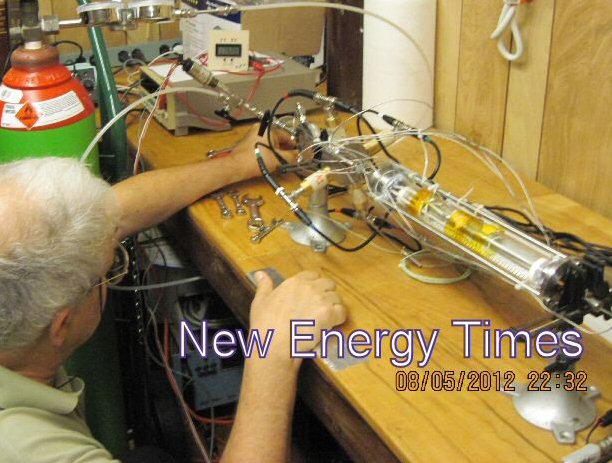
Francesco Celani loading the LENR reactor with hydrogen on Sunday night at Lettslab. (Photo credit Dennis Letts)
For this demonstration, Celani loaded the nickel wire for three days in Rome before bringing it to Texas. Because he and Letts could not bring cylinders of pressurized gas into the convention center, they took the wire that had been pre-loaded in Rome and loaded it a little more in Letts’ lab on Sunday night.
“We tested it, saw that it produced excess heat, shut it off and went home at midnight,” Letts said. “On Monday morning, we came back to my lab, disassembled it, brought the reactor into the convention center and reassembled it there.
“As soon as we applied the electrical power to the internal nichrome-wire heater (48 Watts DC), we began to see excess heat. There was no incubation period. Celani has eight thermocouples in the reactor, and he measured between 58 and 68 Watts heat output. So, conservatively, it produced an average of 10 Watts of excess heat continuously from the time we started, at 1 p.m., until we left, at 7 p.m. – for six hours.”
Letts was happy to see the effect but realized that the conditions were not perfect. New Energy Times asked Letts if he and Celani had data on the integrated energy, but they did not have that information yet.
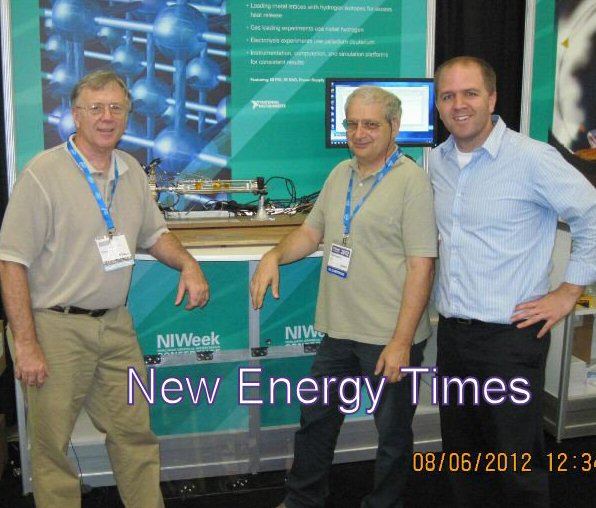
Dennis Letts, Francesco Celani and Chad Evans. (Photo credit Dennis Letts)
Letts told New Energy Times that a precise calibration was not possible because of time limitations and regulations that prevented them from bringing gas cylinders into the convention center.
“We would have preferred to run control experiments there using noble gases to obtain a baseline, but that wasn’t possible,” he said, “It was also impossible to control room temperature and thus obtain very precise calorimetry, but the variance in room temperature as it might have affected the output would have been minimal.
“I’m happy to see it. It seems like a solid effect, and I also would like to have seen the device running for some time during the loading period to see the baseline, with no excess heat, for a few hours.
“Celani has another way that he checks the system. His configuration includes another wire that is inert going into the cell. He can switch the power over from the active wire to the inert wire, without changing anything else in the system, and he can use that to establish a baseline.”
Letts told New Energy Times that National Instruments provided three engineers to assist with the configuration.
“The engineers from National Instruments did a fabulous job in putting it all together and doing the wiring and getting all the parts we needed,” he said. “And of course, we were using LabVIEW.”
Frank Gordon, formerly the head of the Navigation and Applied Sciences Department at the U.S. Navy’s Space and Naval Warfare Systems Center in San Diego, told New Energy Times on Monday that Celani will be packing up the demonstration device and taking it to Seoul, South Korea, for the 17th International Conference on Cold Fusion, which will take place there next week.
Gordon is the co-chair of the ICCF-17 conference. He told New Energy Times that National Instruments will send an engineer to Korea to assist with the demonstration reactor.
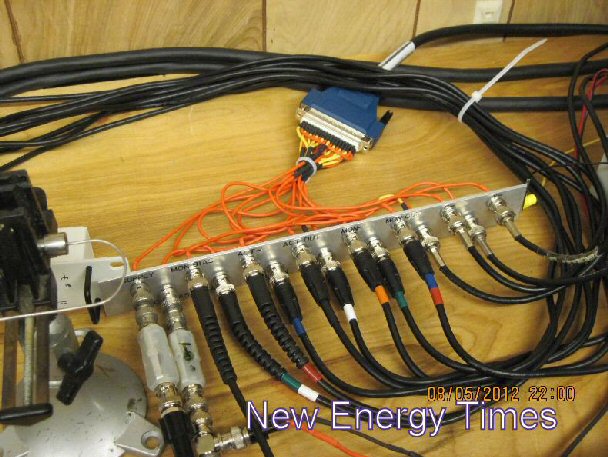
Wiring assembly improvised by National Instruments engineers to make measurements for Celani’s reactor. (Photo credit Dennis Letts)
The Experts Speak
On Tuesday at 4:45 p.m., National Instruments will host a one-hour “Experts Panel Discussion – Quest for Alternative Energy: Anomalous Heat Effect (AKA Cold Fusion).”
The panelists are Andrea Aparo, senior adviser of research and development at Ansaldo Energia SpA, Akito Takahashi, professor emeritus at Osaka University and senior adviser at Technova Inc., Michael McKubre of SRI International, Robert Duncan, vice chancellor for research at the University of Missouri, and Gordon.
Robert E. Godes, president and chief technology officer of Brillouin Energy Corp., had been scheduled for the panel, but he has been given his own speaking slot on Wednesday, along with Takahashi.
Brillouin is based in the San Francisco Bay area and has applied for a LENR patent. New Energy Times spoke with Godes on Monday. Our first question to him was how to pronounce the name of his company.
“Brillo – like a Brillo pad – then ‘in,’” Godes said.
“National Instruments asked me to come and talk about commercial aspects of the technology because people realize that I am onto something,” he said. “I’ve got control of the heat effect, which is the key to making this phenomenon a technology.”
Godes is another of the few LENR researchers who has consistently worked with light hydrogen rather than deuterium. Godes’ research has been with nickel-hydrogen electrolytic systems and will soon include gas-phase nickel-hydrogen systems.
Takahashi will speak on “The Status of CMNS/CF/LENR Research at Kobe-Technova.”
John Hadjichristos, of Defkalion Green Technologies, is scheduled to talk about “Commercialization of LENR.” Thus far, Defkalion has presented no scientifically credible evidence or demonstration despite its extensive media events.
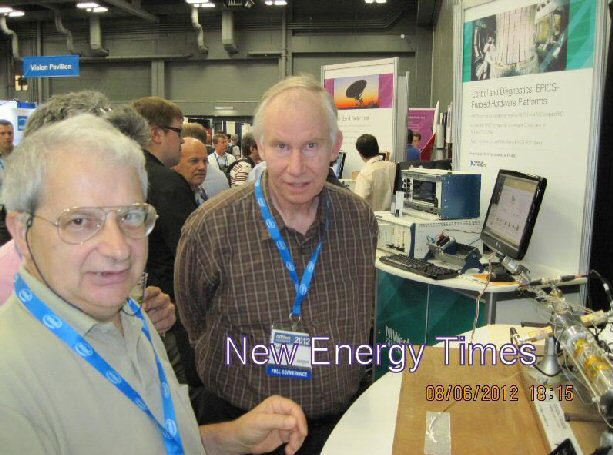
Franceso Celani and Peter Hagelstein at NI Week on Monday. (Photo credit Dennis Letts)

Francesco Celani at NI Week on Monday explaining to Michael McKubre how his reactor works. (Photo credit Dennis Letts)
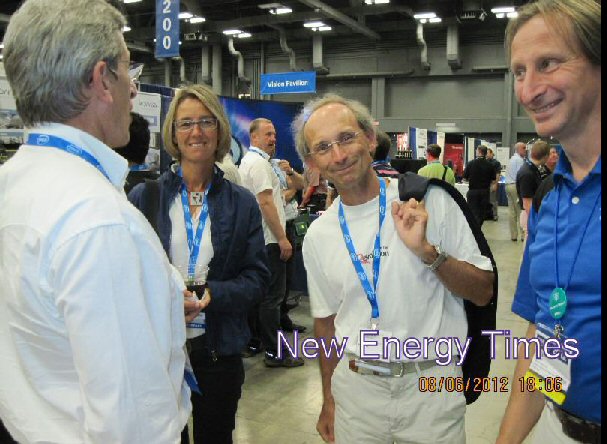
Francesca Sarto and Vittorio Violante talking with National Instruments engineers from Italy at NI Week on Monday. (Photo credit Dennis Letts)
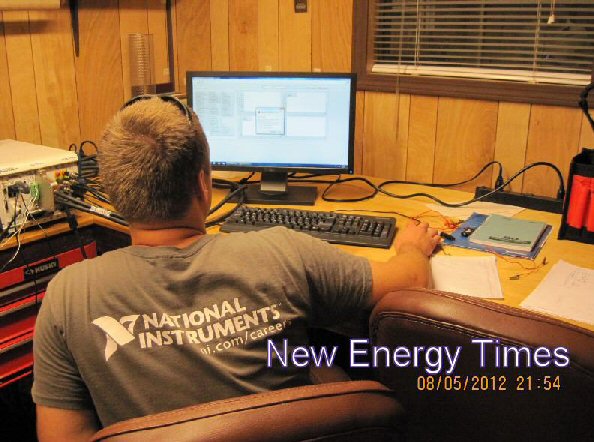
Brian Glass writing National Instruments’ LabVIEW code to measure parameters for Celani’s reactor at Lettslab. (Photo credit Dennis Letts)
*Update Aug. 7, 2pm: Received from Julia Betts, corporate communications and investor relations manager of National Instruments, on behalf of Stefano Concezzi, vice president of scientific research segment and lead user program:
“NI is interested in providing the best tools such as LabVIEW software and NI PXI and CompactRIO hardware towards science research to help understand the underlying physical phenomena behind LENRs and to perform advanced measurements and control on the experiments. National Instruments mission is to equip any scientist and engineer seeking to accelerate productivity, innovation and discovery.”

